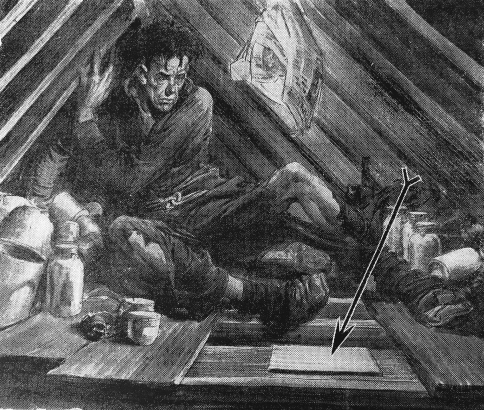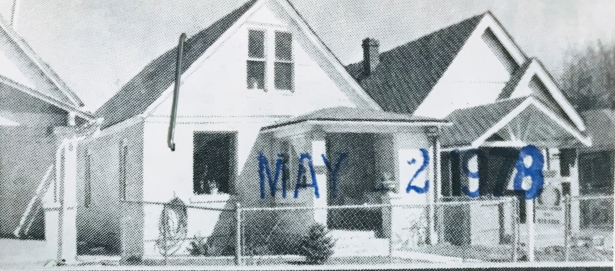This is the story of the Denver Spider Man and the murder that perplexed Denver Police for nearly a year. Sadly, he was not a masked vigilante protecting the people of the Mile High City, swinging from webs after being bitten by a radioactive spider.
He was the murderer.
The victim’s name was Philip Peters. He was a retiree of the Denver & Rio Grande Western Railroad and had lived in his home on West Moncrieff Place for over three decades. He was married to Helen, and their children were now adults, one of whom lived in Grand Junction.
Not only was Peters a former railroad employee, husband and father, but he was also a musician and member of the Denver Guitar Club, where he and his wife sometimes gave guitar and mandolin lessons. In fact, it was through the Denver Guitar Club that Peters first met the man who would be his murderer.
For the five weeks leading up to his murder he had been staying in his house alone because Helen was recovering at St. Anthony’s Hospital after breaking her hip in a fall. His neighbors opened their homes to him in the evenings so that he wouldn’t have to be alone at dinner time, and so he could enjoy a hot, home-cooked meal and leftovers to take for his lunch the next day.
On the night of October 17, 1941, Peters discovered a tall, gaunt, and disheveled man raiding his icebox. A fight ensued, and the interloper grabbed Peters’s cast iron stove shaker and beat him to death with it before fleeing. Peters was discovered an hour later by his worried neighbors, and the Denver Police were called. They searched the house, but couldn’t find any evidence of the murderer. It was as if he had vanished into thin air.
While detectives dug into Peters’s past, searching for enemies who hated him enough to want him dead, Mrs. Peters was eventually released from the hospital and returned home a widow. A good friend of hers moved in to help around the house.
In the months following Mrs. Peters’s return, she and her friend reported strange things happening around the West Moncrieff Place house: food missing, strange sounds, things out of place. The friend was convinced the house was haunted and resigned, while Mrs. Peters decided to relocate to Grand Junction to live with her son.
So the house stood vacant, and the strange sounds and disgusting smells continued to be reported to the police, but they couldn’t find anyone in the house.
Everything changed in July 1942 once Denver Police decided to station two detectives, Roy Bloxom and Bill Jackson, outside the house and keep it under surveillance instead of waiting for a call from the neighbors. The vigilance paid off when Bloxom and Jackson spotted a man inside the house. They ran inside, but the house was empty.
Until they heard a noise upstairs.
They opened a closet door just in time to spot a pair of legs disappearing up into a small opening to the house’s attic. They grabbed the legs and pulled the man attached to them back to the ground. They had caught their man.
The suspect was arrested and taken downtown, where he confessed to his crime and told his story.
Theodore Coneys was born in Illinois in the 1880s, but came to Denver in the 1910s, where he remained. As a child he had poor health, which continued to plague him into adulthood. Because of his health and perhaps also because of the Great Depression, Coneys struggled to keep a job long-term, and frequently found himself without a place to live except for doorways and alleys around Denver.
At some point, Peters and Coneys had become acquainted at the Denver Guitar Club, so one evening Coneys went to the Peters’ house hoping to be able to ask them for some money and maybe something to eat. Unfortunately, this was when Helen was at the hospital and Peters was keeping her company, so no one was home. Coneys decided to break into the house to steal food. A few days later, he tried to do it again but this was when he was found by Peters.
Coneys insisted to police that beating Peters had been a split-second decision. After he had killed Peters, Coneys sought refuge up in the attic, where he stayed until July. Denver Police sent their smallest officer up into the cramped attic where Coneys had made himself a nest of sorts. He had collected his waste and had not bathed during his attic residency, and the stench ended up making the officer vomit. After recovering from losing his lunch, Officer Fred Zarnow said of the attic, “A man would have to be a spider to stand it long up there.” The newspapers heard this, and ran with it. Theodore Coneys was dubbed “The Denver Spider Man,” and a legend was born.
Coneys was charged and convicted of murder by a jury and sentenced to life in prison in October of 1942. He was sent to the state penitentiary in Cañon City, and remained there until his death on May 16, 1967 at the age of 84. He was buried in a nearby cemetary.
Perhaps this tale sounds familiar to you, because the legend lives on. In the 1950s Erle Stanley Gardner mentions this case in his Cool and Lam novel Beware the Curves. CSI: Crime Scene Investigation updated this story for the twenty-first century in season 2 with the episode "Stalker" in 2002. At a live episode at the Boulder Theatre in 2017, co-host of the podcast "My Favorite Murder" Karen Kilgariff shared the story of the Denver Spider Man, which is how yours truly first learned of the story.
Interested in learning more? Check out our clippings file on Theodore Coneys and our digital collections!




Comments
Thank you. This may solve a
Thank you. This may solve a mystery that has perplexed our family for decades and verifies a story my mother told.
"Shortly after my birth, my parents, older sister, and I moved to Henderson, Colorado into an old historic house built in 1887. It was located along the Platte River about 136th and Old Brighton Road south of Brighton. They nicknamed it, “Skunk Holler (Hallow)”. In fact, I celebrated my first birthday in this home. We lived there from approximately 1944 to 1947.
The history of the area is documented in Wikipedia. Quote: "In 1859, John D. “Colonel Jack” Henderson built a ranch, trading post, and hotel on Henderson Island in the South Platte River in Arapahoe County, Kansas Territory. Jack Henderson was the former editor and proprietor of the Leavenworth (Kansas Territory) Journal and an outspoken pro-slavery politician who had been accused of voter fraud in eastern Kansas. Henderson sold meat and provisions to gold seekers on their way up the South Platte River Trail to the gold fields during the Pike’s Peak Gold Rush. Henderson Island was the first permanent settlement in the South Platte River Valley between Fort Saint Vrain in the Nebraska Territory and the Cherry Creek Diggings in the Kansas Territory. Jack Henderson eventually returned to eastern Kansas and (ironically) fought for the Union in the American Civil War. Henderson Island is today the site of the Adams County Regional Park and Fairgrounds."
The 1887 Henderson Home was built on the land that Jack Henderson once owned. Overtime, it was a hotel, a boarding house, a brothel, and home to over forty known families. Being half Volga German (Germans from Russia), I researched the census records to learn about the history. Many of the families who lived in the area from the 1910s to the 1940s were of German descent. Many were Volga Germans.
My mother told several interesting stories about the house including one about a woman who was living alone in Denver. The woman would come home from work and find things moved or food missing. She did not think too much about it. She just assumed she had bumped the furniture before she left home or had eaten the groceries without remembering. One day, she returned home early and found a dirty and disheveled man standing in her kitchen. It turned out he was an escapee who had been hiding in her attic. He would sneak down during the day to use the bathroom and get a bite to eat. He was arrested and returned to prison.
At the same time, my parents would get up in the morning and find their attic scuttle (door) was moved slightly. My mother was scared, thinking that someone was in the attic. Day after day my father would put the scuttle back into place. Every morning they would find it moved again. She would insist my father go up there to check. This involved my father carrying a heavy ladder up the narrow steep stairs each day. Of course, he did not find a convict hiding or anything or anyone else for that matter. My father's ornery teenaged brother, who came from Kansas for a few months, was staying with them. After several days of this ritual, he finally confessed that he was the one moving the scuttle during the night as a prank.
The house has been moved to the Adams County Historical Society Museum complex at 9601 Henderson Road, Brighton, Colorado where it has been restored and furnished. It is available for tours along with a 1935 filling station, vintage firehouse, blacksmith shop, one-room school house, railroad caboose, Hoffman hall, and several museum buildings. Many events are held there including teas, car shows, craft fairs, heritage days, and holiday open houses.
I recall seeing a newspaper article about the man hiding in the woman's attic. I am looking for documentation to confirm or correct the story. I would appreciate your help in finding the article or information. I know that the Denver Public Library has some old newspapers available on microfilm."
Thanks for reading and for
Thanks for reading and for your story, Shirley. You can submit a request for help finding that article at https://history.denverlibrary.org/contact-us.
Well I guess he proved the…
Well I guess he proved the doctors wrong eh? They said he would not live long yet he lived to be 84 ( outlived his doctor) like Benjamin Franklin! However he was a total sociopath for him to give his last words speech of thank you to the jury, D.A. and Judge that I will never have to be homeless anymore??? No remorse, guilt or empathy for his victims at all!
Wonderful Article Caroline!…
Wonderful Article Caroline! I'd love to interview you for my podcast about this if you might be interested. Is there a way I might contact you?
Add new comment